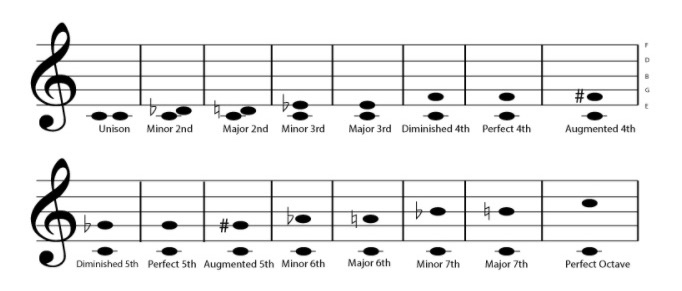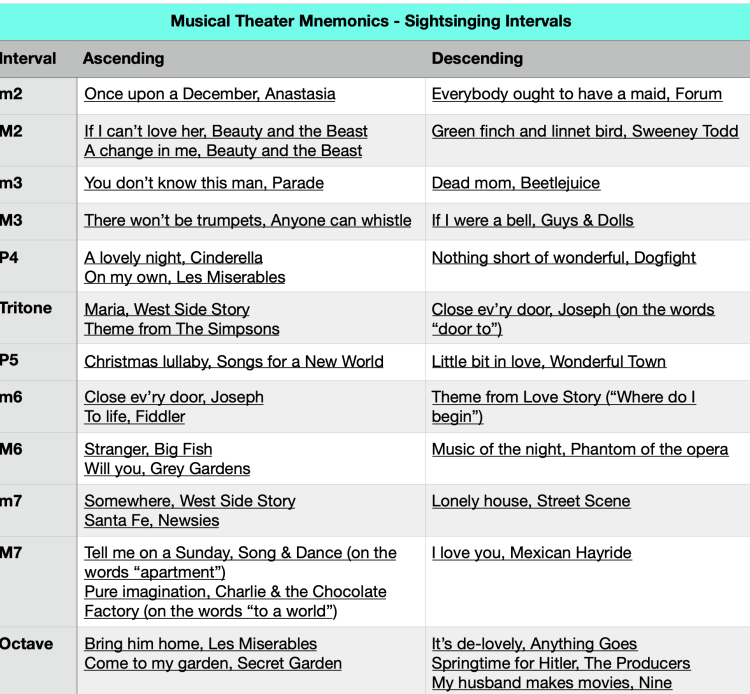When you learn to read music, one of the most important elements is learning to read intervals on the staff. This is in reference to how close notes are to each other on the staff. The distance of a 2nd, 3rd, etc., refers to the proximity of the bottom note to the top, counting the bottom note as 1. (I don’t know why the 4th and 5th steps and the octave of the scale are referred to as perfect.)

Learning memory tricks, or mnemonics, is very helpful in helping you learn to sightread. When I was in undergrad sightsinging, I was given a list of songs that corresponded to the different melodic intervals of a 12-note chromatic scale. The ones I remember the best were:
P4⬆️ “Here comes the bride”
P4⬇️: “Born free”
M6⬆️: “My Bonnie lies over the ocean”
(For a minor 6th, I always thought of it as “sad my Bonnie.”)
Nowadays, people don’t know the traditional folk songs the way they used to (never mind oldies like “Born Free”), so when I offer one of them as a mnemonic device, I’m met with blank stares.
But what y’all DO know is musical theater. So I sat down today and created this (which I edited because someone caught a mistake PLUS it gave me the chance to close a parentheses I’d missed):

(Tritone = augmented 4th or diminished 5th. Also known as the Devil’s Interval.)
Click here to access the file along with YouTube links to each song: Sightreading with Musical Theater Intervals
Take the opportunity of this unplanned social isolation to work on your sightreading. Or on your improvisation skills. Or a monologue.
Like this:
Like Loading...
Published by Mezzoid Voice Studio
Christine Thomas-O'Meally, a mezzo soprano and voice teacher currently based in the Baltimore-DC area, has performed everything from the motets of J.S. Bach to the melodies of Irving Berlin to the minimalism of Philip Glass.
As an opera singer and actress, she has appeared with companies such as Charm City Players, Spotlighters Theatre, Chicago Opera Theater, Opera Theater of Northern Virginia, Opera North, the Washington Savoyards, In Tandem Theatre, Windfall Theater, The Young Victorian Theater of Baltimore, and Skylight Opera Theatre. She created the role of The Woman in Red in Dominick Argento’s Dream of Valentino in its world premiere with the Washington Opera and Mary Pickersgill in O'er the Ramparts at its world premiere during the Bicentennial of Battle of Baltimore at the Community College of Baltimore County. Other roles include Mrs. Paroo in Music Man, Mother Abbess in Sound of Music, Dorabella in Cosi Fan Tutte, Marcellina in Le Nozze di Figaro, both Hansel and the Witch in Hansel & Gretel, and many roles in Gilbert & Sullivan operettas. Her performance as the Housekeeper in Man of La Mancha was honored with a WATCH award nomination.
Ms. Thomas-O'Meally received an M.M. in vocal performance from the Peabody Conservatory in Baltimore. She regularly attends master classes and workshops in both performance and vocal pedagogy, and is certified in all three Levels of Somatic Voicework™ The LoVetri Method. Her students have performed on national and international tours of Broadway productions, at prestigious conservatories, and in regional theater throughout the country.
View more posts


Did you mean “door to” for descending tritone? 🙂
Yep. Caught that later…. I’ll fix it.
Thanks again! That gave me the chance to close the parenthesis I’d missed as well. 😀
Did you mean “door to” for descending tritone? 🙂
Yes. Sorry I didn’t answer that! Sometimes I forget that, if I just nod at the computer screen, people can’t hear it.